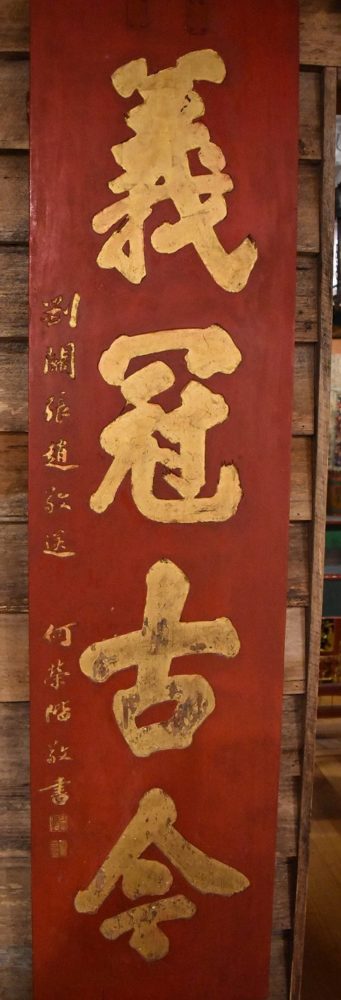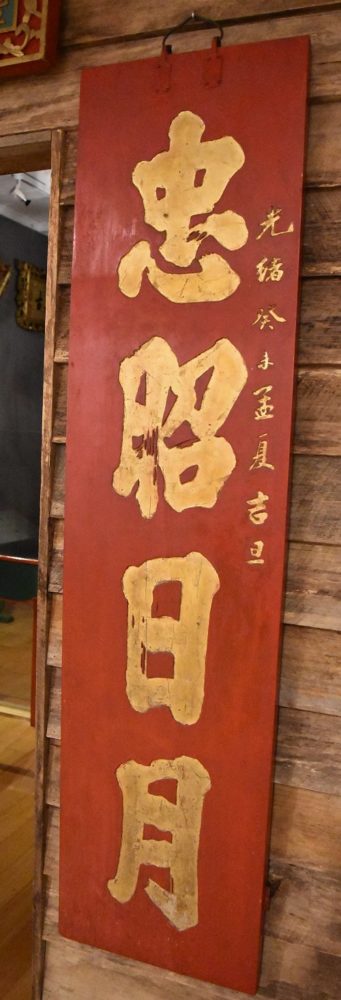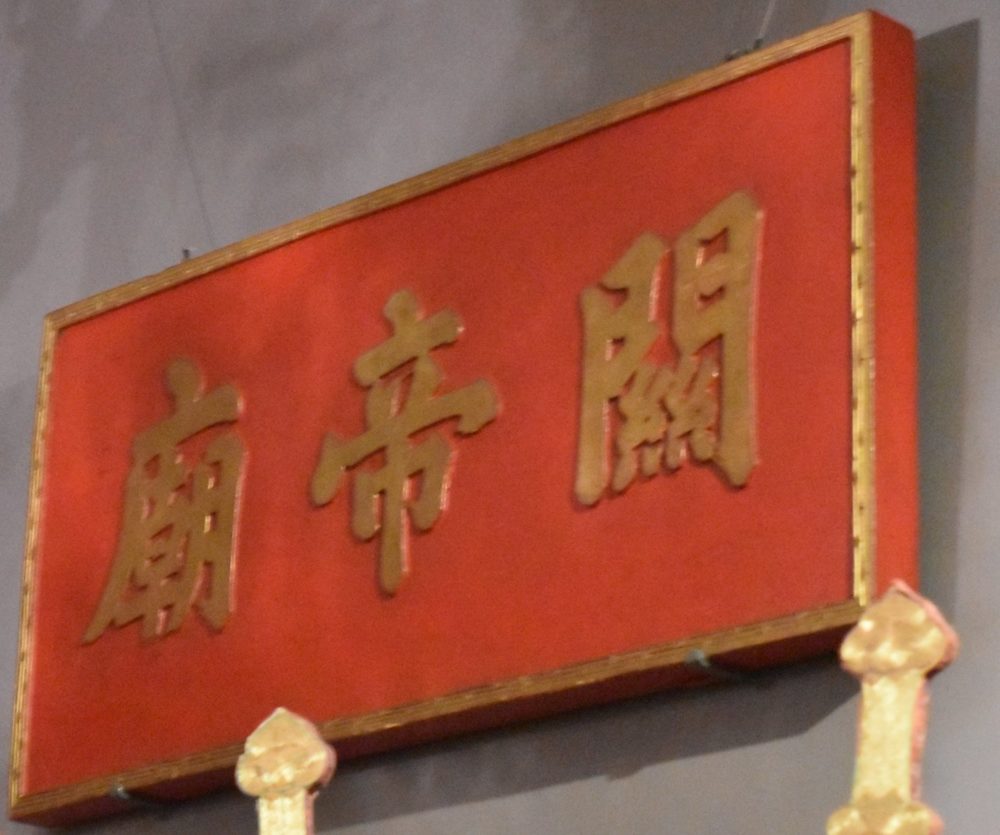This page is part of a series of linked posts. You want to start with the main page
This one being the best known and most frequently mentioned, I’m just including material relating to its opening, closure and useful descriptions.
The first mention of a joss house at Weldborough or Thomas Plains predates the opening of the building by almost a year:
From “The Chinese Camp at Thomas’ Plains”
The Joss-house is frequented, and bushels of crackers burnt, the debris from which bestrews the whole camp.
The Mercury, 15 February 1883
The opening was apparently a big event in the area.
New Joss House. We have been informed that at the end of the present month a new Joss House will be opened in the Chinese Camp at Thomas Plains, when a grand display of fireworks and colored lights will also take place in connection therewith. On this occasion the Chinese resident in the district are to appear in their native dresses and gorgeous regalia, in order that they may help in the opening ceremony. The gathering is to last two days.
Daily Telegraph, 24 January 1884
New Joss House.–We have been interviewed by the high priest (about 5ft 6in) who is to officiate at the inauguration of the new Joss House at Thomas Plains on the 31st inst. The ceremony is to be of a most imposing, character, as the Mongolian dresses, emblems, banners, regalia, and fireworks are to be gorgeous, and the music–most ancient; from Pekin—-celestial. The ceremonies will occupy two days and nights, viz., Thursday and Friday next, 31st January and 1st February. We envy the inhabitants of Thomas’ Plains, who will have full opportunity of. witnessing the mysterious ceremonies on this occasion. The admission is free, and all are invited.
Daily Telegraph, 26 January 1884
GEORGE’S BAY.
[FROM OUR OWN CORRESPONDENT.]
Thursday last was a red letter day for the people at Thomas’ Plains, being the commencement of the New Year with the Chinese. There was a great muster of that nation, as well as Europeans. The fireworks that were let off in the evening were certainly very beautiful, being imported direct from China, The Joss consists of a painting of an immense personage, and two much smaller figures, one on each side. Pigs were roasted whole, weighing from 80 pounds tot90 pounds, and were well done all through. Before being eaten they were placed in the Joss House before the Joss, and left for about an hour, for him to get his supper first. Strange to say, a t the end of the time allowed the Joss for his repast, when his worshippers went for the pigs, they had not been cut into a t all, his lordship, 1 suppose, not being hungry. The Chinese were very hospitable, and paid every attention to the visitors, supplying them with all sorts of good things in the shape of preserves, spirituous liquors, and other luxuries. I believe that all the horses at George’s Bay were in requisition to carry the visitors from here to the plain. The fireworks, I understand, cost a lot of money, and one may easily imagine they* must have done so, when one alone cost £30, and was something to he remembered. The carving of the wooden frame work of the picture was really a beautiful piece of workmanship, and is well worth seeing.
Tasmanian News, 6 February 1884
But John, like all other thinking animals, must have his religion : it may be hard to reduce it an intelligible issue, what with its mythological figures, fables, fireworks and fatality. Still to him, it is everything, and no sooner are we favoured with an imperfectly macadamized highway than it is immediately utilised in supplying him with the necessary helps in support of his faith. Almost the first dray load of merchandise brought directly on to the plains consisted of a costly set of religious furnishments, including of course a brand new Joss, with fireworks, drums, gongs, and cymbals to boot, hence the unlovely outburst, hinted at in the opening of these notes. To one whose musical fibre seems attuned to nature’s pitch there is something horribly aggravating in John’s musical efforts. I can liken them to nothing better than a tin-kettle corrobborree breaking in upon a marriage feast. Whatever may be tho moral excellencies involved on the philosophical teachings of Confucius, it is to be regretted that he, though skilled himself to play upon a lute with ten silken strings, left nothing recorded to enlighted his countrymen touching the concord of sounds.
Mercury 6 February 1884
There is a photo of Welborough Joss House at the School House Museum at Derby:
The panels either side of door are those flanking the entrance to the Queen Victoria Museum’s temple exhibit.


The large text is something along the line of “Loyalty shining clearly understood/United in brotherhood from past to present.” The smaller column of text on the right gives the date: May-June 1883
And above the door is this panel:

It just says “Guan Di Temple” (and it’s the same as the one I htink is in the Garibaldi photo).
Now some descriptive paragraphs:
CHINESE NEW YEAR FESTIVAL.
By A. R. Browne
Whilst up on Thomas Plains inspecting a mine, I took the opportunity of visiting the Chinese head-quarters at holiday time. It was Chinese New Year, and was celebrated by a week of merry-making, starting from January 31; besides, a new joss house had just been erected and was being inaugurated. The camp is in reality a town situated about a mile from Weldborough on the face of a gully surrounded on three side by dense forest. Entering from the east side and from the principal street, the ears are assailed by a noise similar to that produced by the clashing together of saucepans, kettles, and other articles, from the culinary regions.
The first thing that meets the eye is wooden shanties, Chinese lanterns, and last but not least, Chinese literally in swarms. The noise proceeded from the two first huts of the street, which proved to be the joss- houses or churches. The Chinese religion is a saint worship. The two josshouses are consecrated, the old one to the patron saint, and embodiment of bravery, a saint corresponding with the Sir Galahad of Saxon legendary, the new one to the saint of longevity and health; this saint has a hundred sons, each of whom has a hundred sons. The old josshouse is a room richly papered with dark red velvety hangings, opposite the door a table covered with cloth embroidered with gold, green, and purple silk, and garnished with pieces of silver and glass ; this was the altar, on it stood a small lamp extemporised out of a tumbler containing the oil with a bit of cork supporting the wick ; also several vases, some containing joss sticks, which when burnt emit the odour of pastilles others thin slips of wood with Chinese writing on them. The Chinese are a superstitious people, and when embarking in any new enterprise consult Joss by drawing a slip of wood on which they are told whether they shall have good or bad luck. Behind the table stands a screen carved out in peculiar gaudily coloured figures, on looking through or behind this, is seen the image of the Joss in relief with a small lamp suspended in front of it; around the walls are large ornamental pikes, fixed on stands. Now for the noise. It was produced by half-a-dozen Chinamen, one hammering on a large wooden drum, one on a small one, a third clashing a pair of enormous cymbals, whilst two or three more battered away on most unmusical gongs, with pieces of wood. There were several Chinese in the room smoking their pipes and talking. The whole scene was lighted up by his beautifully-wrought lanterns suspended from the ceiling, whilst outside the door hung two more, but of paper. The second house was but a repetition of the first, except that it contained a sort of banner shaped like a small round table, with a long, richly embroidered cloth on it. I was informed the noise was kept up for five days and nights to serve the double purpose of keeping the joss awake, and frightening the devil away.
Mercury, 16 February 1889
From “The Bush Fires”
At Weldborough there are still close on 200 Chinamen at work on tribute. The Chinese camp is a large one, and they are provided with a Josshouse. This edifice, in which the almond-eyed Mongolians worship, is well worth inspection. The outside is painted in bright colours, and the inside kept scrupulously clean. It is decorated with large Chinese lamps and tinsel, with brightly burnished heathen figures, and furnished with a variety of warlike implements, used, no doubt, in connection with high festival. The grotesquely got-up deity is partly sheltered behind a curtain, in front of which there is what might be called an altar with a sumptuous repeat laid out, which I was told is placed there twice a day, and then taken away and consumed. There is a separate compartment reserved for Joss with his wife and family, which is similarly embellished.
Mercury, 21 February 1898
The Chinese Camp is situated just off the main road, and occupies such a small space that it might be passed unnoticed, but in spite of this there are some neat cottages, and most interesting of all a Joss House, or Chinese temple.’By the courtesy of one of the chief residents Maa Mon Chinn, I was taken into the Joss House and shown round, and as it is built and furnished in exactly the same way as the Joss houses in China. Standing within, with the outer door shut, one could easily imagine that he had been suddenly transferred to a foreign land. The only familiar object within was a large child’s rocking horse, such as can be seen in many a British home where the parents have the means to indulge their children. In this case however, my guide informed me, it was provided so that the fierce looking joss who ruled within, may be able to take a ride when he choo- -. The horse however, shows no marks, of whip or spur, and it struck me -that joss must be rather lazy. Asked as to whether his countrymen came .there to- worship much, he replied, “No, my countrymen no very good, no come here many, very bad, very bad.” The number of Chinese at the camp is fewer than formerly, but those that are there seem to be comfortably off.
Daily Telegraph, 16 November 1901
Then the closing/transfer to Launceston
Unusual Mission
An unusual mission over the week-end resulted in a unique acquisition for the Queen Victoria Museum, Launceston. A relic of the days where there was a large Chinese population at. Weldborough was the ornate Joss House with its fittings, which originally cost about £3000. For several years it has brought welcome contributions to the hospital by way of donations from visitors. Negotiations were opened recently to transfer the joss house to Launceston, and over the week-end the Mayor (Alderman A. Hollingsworth), Messrs. Eric Scott, D. S. Jackson, Walter Hedge, and Chung Gon (leader of the Chinese community) travelled to Weldborough and in two trips by lorries transferred the joss house to Launceston. The joss house, which should prove an intensely interesting exhibit, has some valuable carvings, and should be a particularly welcome addition to the Museum from the educational and religious viewpoint.
Examiner, 18 December 1933
Amongst all the stories about the opening of the new exhibit, there is some talk about the origins of the Weldborough temple.
It is explained that the Chinese who worked at Weldborough chose Kwan Ti as their joss in preference to such an intellectual figure as Confucious because they were poor working men, strangers in a new land, many not even speaking its language. They did not know its laws and looking upon Kwan Ti as their protector and judge, invariably settled their disputes before his altar. This is the centre of all sentiment in the joss house, and the central piece is a portrait of Kwan Ti with one of his sons standing by one shoulder and his bodyguard by the other.
Description of museum’s exhibit in Examiner, 19 June 1937
About 60 years ago, when a number of Chinese were engaged on mining at Weldborough and other centres on the North-East Coast, the present Joss Kwan-ti painting was taken there by a Chinaman and hung in his hut. He and others consulted it with the divining sticks regarding their future and their troubles, and it was said that the oracles always came true.
With the arrival of more Chinese, it was decided to build a temple for the Joss, so that everybody could go and worship or settle a dispute by taking an oath. When the Chinese community left the coast, the Joss House became neglected, and it was due to the thoughtfulness of Mr. Jackson and Mr. Walter Hodge that it had been saved from falling into ruin.
Examiner, 2 July 1937
I wonder if the painting in the hut is the “Joss House” referred to in the lines at the very top of the post?

